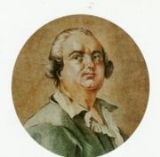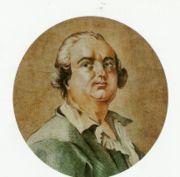
Cagliostro in Wien
Encyclopedia
Cagliostro in Wien is an operetta
in three acts by Johann Strauss II
to a libretto
by F. ZellF. Zell was the pen name
of Camillo Walzel
(1829–1895). and Richard Genée
. It premiered on 27 February 1875
at the Theater an der Wien
, featuring Marie Geistinger and Alexander Girardi
.
. However, weaknesses in the libretto and the —by Strauss's standards— pallid music meant the work could not garner the level of long-term public support of the composer's other works. These shortcomings were corrected in a revised version (libretto: Gustav Quedenfeldt, music: Karl Tutein, who included themes from the Kaiser-Walzer
) which premiered on 8 May 1941 in Danzig
(Gdańsk).
 Johann Strauss used material from his operetta for the following works:
Johann Strauss used material from his operetta for the following works:
Erich Wolfgang Korngold
wrote an arrangement of the work, first performed on 13 April 1927 in Vienna.
Operetta
Operetta is a genre of light opera, light in terms both of music and subject matter. It is also closely related, in English-language works, to forms of musical theatre.-Origins:...
in three acts by Johann Strauss II
Johann Strauss II
Johann Strauss II , also known as Johann Baptist Strauss or Johann Strauss, Jr., the Younger, or the Son , was an Austrian composer of light music, particularly dance music and operettas. He composed over 500 waltzes, polkas, quadrilles, and other types of dance music, as well as several operettas...
to a libretto
Libretto
A libretto is the text used in an extended musical work such as an opera, operetta, masque, oratorio, cantata, or musical. The term "libretto" is also sometimes used to refer to the text of major liturgical works, such as mass, requiem, and sacred cantata, or even the story line of a...
by F. ZellF. Zell was the pen name
Pen name
A pen name, nom de plume, or literary double, is a pseudonym adopted by an author. A pen name may be used to make the author's name more distinctive, to disguise his or her gender, to distance an author from some or all of his or her works, to protect the author from retribution for his or her...
of Camillo Walzel
Camillo Walzel
Camillo Walzel was an German librettist and theatre director, who wrote under the pseudonym F Zell.Walzel was born in Magdeburg. In his early years, he worked in his father lithographic factory, then studied in the Wiener Akademie der bildenden Künste, before joining the army...
(1829–1895). and Richard Genée
Richard Genée
Franz Friedrich Richard Genée was a Prussian born Austrian librettist, playwright, and composer.Genée was born in Danzig. One of his best known works was the libretto of Karl Millöcker's operetta Der Bettelstudent, which he co-wrote with Friedrich Zell .In 1876, Genée composed the operetta Der...
. It premiered on 27 February 1875
1875 in music
- Events :* March 3 - Georges Bizet's Carmen debuts in Paris.* May 6 - Richard Wagner conducts portions of Götterdämmerung in concert in Vienna ....
at the Theater an der Wien
Theater an der Wien
The Theater an der Wien is a historic theatre on the Left Wienzeile in the Mariahilf district of Vienna. Completed in 1801, it has seen the premieres of many celebrated works of theatre, opera, and symphonic music...
, featuring Marie Geistinger and Alexander Girardi
Alexander Girardi
Alexander Girardi was an Austrian] actor and tenor singer in operettas.- Career :Girardi was born in Graz; his father was the locksmith Andreas Girardi who had migrated to Graz from Cortina d'Ampezzo. Following the early death of his father, Alexander Girardi was raised by his stepfather who put...
.
Reception
The premiere was highly successful, in no small part due to the audience favourite Alexander Girardi (1850–1918) as Blasoni. Another notable performer at the premiere was Marie Geistinger (1836–1903) who had created the role of Rosalinde in Strauss's Die FledermausDie Fledermaus
Die Fledermaus is an operetta composed by Johann Strauss II to a German libretto by Karl Haffner and Richard Genée.- Literary sources :...
. However, weaknesses in the libretto and the —by Strauss's standards— pallid music meant the work could not garner the level of long-term public support of the composer's other works. These shortcomings were corrected in a revised version (libretto: Gustav Quedenfeldt, music: Karl Tutein, who included themes from the Kaiser-Walzer
Kaiser-Walzer
Kaiser-Walzer, Op. 437 is a waltz composed by Johann Strauss II in 1889. The waltz was originally titled Hand in Hand and was intended as a toast made in August of that year by Austrian emperor Franz Josef on the occasion of his visit to the German Kaiser Wilhelm II where it was symbolic as a...
) which premiered on 8 May 1941 in Danzig
Gdansk
Gdańsk is a Polish city on the Baltic coast, at the centre of the country's fourth-largest metropolitan area.The city lies on the southern edge of Gdańsk Bay , in a conurbation with the city of Gdynia, spa town of Sopot, and suburban communities, which together form a metropolitan area called the...
(Gdańsk).
Roles
| Role | Voice type Voice type A voice type is a particular kind of human singing voice perceived as having certain identifying qualities or characteristics. Voice classification is the process by which human voices are evaluated and are thereby designated into voice types... | Premiere cast, 27 February 1875 (Conductor Conducting Conducting is the art of directing a musical performance by way of visible gestures. The primary duties of the conductor are to unify performers, set the tempo, execute clear preparations and beats, and to listen critically and shape the sound of the ensemble... : Johann Strauss II) |
|---|---|---|
| Empress Maria Theresia Maria Theresa of Austria Maria Theresa Walburga Amalia Christina was the only female ruler of the Habsburg dominions and the last of the House of Habsburg. She was the sovereign of Austria, Hungary, Croatia, Bohemia, Mantua, Milan, Lodomeria and Galicia, the Austrian Netherlands and Parma... |
||
| Marie Luise Infanta Luisa Fernanda, Duchess of Montpensier Infanta María Luisa Fernanda of Spain was Infanta of Spain and Duchess of Montpensier. She was the youngest daughter of king Ferdinand VII of Spain and his fourth wife Maria Christina of the Two Sicilies, the queen-regent, who was also his niece.-Biography:-Heiress-presumptive:When her elder... , Infanta of Spain |
||
| Baron Sebastian Schnucki, imperial custodian of morals | ||
| Count Cagliostro Alessandro Cagliostro Count Alessandro di Cagliostro was the alias of the occultist Giuseppe Balsamo , an Italian adventurer.-Origin:The history of Cagliostro is shrouded in rumour, propaganda and mysticism... |
baritone Baritone Baritone is a type of male singing voice that lies between the bass and tenor voices. It is the most common male voice. Originally from the Greek , meaning deep sounding, music for this voice is typically written in the range from the second F below middle C to the F above middle C Baritone (or... |
Carl Adolf Friese |
| Lorenza, Italian street singer | ||
| Feri von Lieven, Lieutenant | ||
| Frau Adamai | ||
| Annemarie, her niece | ||
| Teiglein, pastry cook, Annemarie's guardian | ||
| Blasoni, Count Cagliostro's aide | Alexander Girardi | |
| Severin, owner of a funfair Funfair A funfair or simply "fair" is a small to medium sized travelling show primarily composed of stalls and other amusements. Larger fairs such as the permanent fairs of cities and seaside resorts might be called a fairground, although technically this should refer to the land where a fair is... stall |
||
| Innkeeper of The Turk Sconce Sconce (fortification) A Sconce is a small protective fortification, such as an earthwork often placed on a mound as a defensive work for artillery. It was used primarily in Northern Europe from the late Middle Ages until the 19th century. This type of fortification was common during the English Civil War, and the... |
||
| The Hofmarschall Hofmarschall The Hofmarschall was the administrative official in charge of a princely German court, supervising all its economic affairs.... |
||
| Beppo and Barberino, Count Cagliostro's aides | ||
| Ladies and gentlemen of the court, people, soldiers, police | ||
Notable arias
- "Zigeunerkind, wie glänzt dein Haar" ("Gypsy child, how shiny your hair")
- "Die Rose erblüht, wenn die Sonne sie küsst" ("The rose will bloom when kissed by the sun")
- "Könnt' ich mit Ihnen fliegen durchs Leben" ("Cagliostro Waltz") ("Could I but fly with you through life")
Adaptations

- Cagliostro-QuadrilleQuadrilleQuadrille is a historic dance performed by four couples in a square formation, a precursor to traditional square dancing. It is also a style of music...
op. 369 (1875) - Cagliostro-WalzerCagliostro-WalzerCagliostro-Walzer op.370 is a waltz by Johann Strauss II composed in 1875 based on themes from his operetta, Cagliostro in Wien which premiered on 27 February 1875 at the famous Theater an der Wien....
op. 370 (1875), waltz - Hoch Österreich op. 371 (Hail Austria) (1875), march
- Bitte schön!Bitte schön!Bitte schön! , opus 372, is a polka composed by Johann Strauss II. The first two themes of the composition incorporate Strauss' operetta Cagliostro in Wien. The composition was first performed in the summer of 1872....
op. 372 (If You Please!) (1875), French polkaPolkaThe polka is a Central European dance and also a genre of dance music familiar throughout Europe and the Americas. It originated in the middle of the 19th century in Bohemia... - Auf der JagdAuf der Jagd"Auf der Jagd" , op. 373, is a polka composed by Johann Strauss II. The composition is based on melodies in Strauss' operetta Cagliostro in Wien . It was first performed in the autumn of 1875....
op. 373 (On the Hunt) (1875), quick polka - Licht und Schatten op. 374 (Light and Shadow) (1875) polka
Erich Wolfgang Korngold
Erich Wolfgang Korngold
Erich Wolfgang Korngold was an Austro-Hungarian film and romantic music composer. While his compositional style was considered well out of vogue at the time he died, his music has more recently undergone a reevaluation and a gradual reawakening of interest...
wrote an arrangement of the work, first performed on 13 April 1927 in Vienna.

